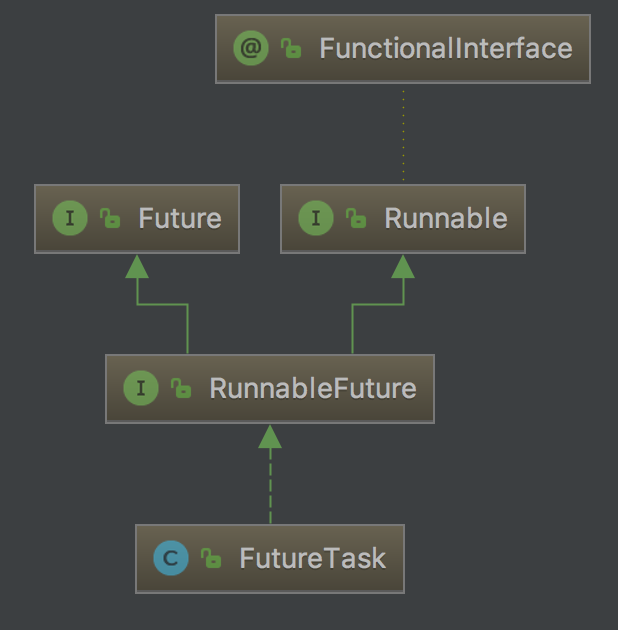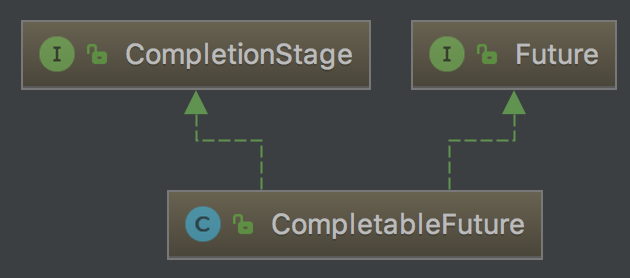005-多线程-JUC线程池-Future、FutureTask、CompletionService 、CompletableFuture
一、概述
创建线程的两种方式,一种是直接继承Thread,另外一种就是实现Runnable接口。这两种方式都有一个缺陷就是:在执行完任务之后无法获取执行结果。如果需要获取执行结果,就必须通过共享变量或者使用线程通信的方式来达到效果,这样使用起来就比较麻烦。而自从Java 1.5开始,就提供了Callable和Future,通过它们可以在任务执行完毕之后得到任务执行结果。
详述:https://www.cnblogs.com/bjlhx/p/7588971.html
1.1、Runnable接口
它是一个接口,里面只声明了一个run()方法:
public interface Runnable { public abstract void run(); }
由于run()方法返回值为void类型,所以在执行完任务之后无法返回任何结果。
1.2、Callable接口
Callable接口位于java.util.concurrent包下,在它里面也只声明了一个方法,只不过这个方法叫做call()。
public interface Callable<V> { V call() throws Exception; }
是一个泛型接口,call()函数返回的类型就是传递进来的V类型。Callable接口可以看作是Runnable接口的补充,call方法带有返回值,并且可以抛出异常。
1.3、Future接口
Future的核心思想是:
一个方法,计算过程可能非常耗时,等待方法返回,显然不明智。可以在调用方法的时候,立马返回一个Future,可以通过Future这个数据结构去控制方法f的计算过程。
Future类位于java.util.concurrent包下,它是一个接口:这里的控制包括:
get方法:获取计算结果(如果还没计算完,也是必须等待的)这个方法会产生阻塞,会一直等到任务执行完毕才返回;
get(long timeout, TimeUnit unit)用来获取执行结果,如果在指定时间内,还没获取到结果,就直接返回null。
cancel方法:还没计算完,可以取消计算过程,如果取消任务成功则返回true,如果取消任务失败则返回false。参数mayInterruptIfRunning表示是否允许取消正在执行却没有执行完毕的任务,如果设置true,则表示可以取消正在执行过程中的任务。如果任务已经完成,则无论mayInterruptIfRunning为true还是false,此方法肯定返回false,即如果取消已经完成的任务会返回false;如果任务正在执行,若mayInterruptIfRunning设置为true,则返回true,若mayInterruptIfRunning设置为false,则返回false;如果任务还没有执行,则无论mayInterruptIfRunning为true还是false,肯定返回true。
isDone方法:判断是否计算完
isCancelled方法:判断计算是否被取消,方法表示任务是否被取消成功,如果在任务正常完成前被取消成功,则返回 true。
也就是说Future提供了三种功能:
1)判断任务是否完成;
2)能够中断任务;
3)能够获取任务执行结果。
Future就是对于具体的Runnable或者Callable任务的执行结果进行取消、查询是否完成、获取结果。必要时可以通过get方法获取执行结果,该方法会阻塞直到任务返回结果。
因为Future只是一个接口,所以是无法直接用来创建对象使用的,因此就有了下面的FutureTask。
使用Callable+Future获取执行结果:

public class Test { public static void main(String[] args) { ExecutorService executor = Executors.newCachedThreadPool(); Task task = new Task(); Future<Integer> result = executor.submit(task); executor.shutdown(); try { Thread.sleep(1000); } catch (InterruptedException e1) { e1.printStackTrace(); } System.out.println("主线程在执行任务"); try { System.out.println("task运行结果"+result.get()); } catch (InterruptedException e) { e.printStackTrace(); } catch (ExecutionException e) { e.printStackTrace(); } System.out.println("所有任务执行完毕"); } } class Task implements Callable<Integer>{ @Override public Integer call() throws Exception { System.out.println("子线程在进行计算"); Thread.sleep(3000); int sum = 0; for(int i=0;i<100;i++) sum += i; return sum; } }
1.4、FutureTask类
FutureTask继承体系中的核心接口是Future。事实上,FutureTask是Future接口的一个唯一实现类。
如何获取Callable的返回结果:一般是通过FutureTask这个中间媒介来实现的。整体的流程是这样的:
把Callable实例当作参数,生成一个FutureTask的对象,然后把这个对象当作一个Runnable,作为参数另起线程。
1.4.1、FutureTask结构

1.4.2、FutureTask使用
方式一、使用thread方式
FutureTask实现了Runnable,因此它既可以通过Thread包装来直接执行,也可以提交给ExecuteService来执行。以下使用Thread包装线程方式启动
public static void main(String[] args) throws Exception { Callable<Integer> call = () -> { System.out.println("计算线程正在计算结果..."); Thread.sleep(3000); return 1; }; FutureTask<Integer> task = new FutureTask<>(call); Thread thread = new Thread(task); thread.start(); System.out.println("main线程干点别的..."); Integer result = task.get(); System.out.println("从计算线程拿到的结果为:" + result); }
方式二、使用 ExecutorService
ExecutorService executor = Executors.newFixedThreadPool(2);线程池方式

public static void main(String[] args) { Callable<String> callable1=()->{ Thread.sleep(2000); return Thread.currentThread().getName(); }; Callable<String> callable2=()->{ Thread.sleep(3000); return Thread.currentThread().getName(); }; FutureTask<String> futureTask1 = new FutureTask<>(callable1);// 将Callable写的任务封装到一个由执行者调度的FutureTask对象 FutureTask<String> futureTask2 = new FutureTask<>(callable2); ExecutorService executor = Executors.newFixedThreadPool(2); // 创建线程池并返回ExecutorService实例 executor.execute(futureTask1); // 执行任务 executor.execute(futureTask2); //同时开启了两个任务 long startTime = System.currentTimeMillis(); while (true) { try { if(futureTask1.isDone() && futureTask2.isDone()){// 两个任务都完成 System.out.println("Done"); executor.shutdown(); // 关闭线程池和服务 return; } if(!futureTask1.isDone()){ // 任务1没有完成,会等待,直到任务完成 System.out.println("FutureTask1 output="+futureTask1.get()); } System.out.println("Waiting for FutureTask2 to complete"); String s = futureTask2.get(200L, TimeUnit.MILLISECONDS); if(s !=null){ System.out.println("FutureTask2 output="+s); } } catch (InterruptedException | ExecutionException e) { e.printStackTrace(); }catch(TimeoutException e){ //do nothing } System.out.println((System.currentTimeMillis()-startTime)); } }
使用Callable+FutureTask获取执行结果

public class Test { public static void main(String[] args) { //第一种方式 ExecutorService executor = Executors.newCachedThreadPool(); Task task = new Task(); FutureTask<Integer> futureTask = new FutureTask<Integer>(task); executor.submit(futureTask); executor.shutdown(); //第二种方式,注意这种方式和第一种方式效果是类似的,只不过一个使用的是ExecutorService,一个使用的是Thread /*Task task = new Task(); FutureTask<Integer> futureTask = new FutureTask<Integer>(task); Thread thread = new Thread(futureTask); thread.start();*/ try { Thread.sleep(1000); } catch (InterruptedException e1) { e1.printStackTrace(); } System.out.println("主线程在执行任务"); try { System.out.println("task运行结果"+futureTask.get()); } catch (InterruptedException e) { e.printStackTrace(); } catch (ExecutionException e) { e.printStackTrace(); } System.out.println("所有任务执行完毕"); } } class Task implements Callable<Integer>{ @Override public Integer call() throws Exception { System.out.println("子线程在进行计算"); Thread.sleep(3000); int sum = 0; for(int i=0;i<100;i++) sum += i; return sum; } }
1.5、CompletionService
原理:内部通过阻塞队列+FutureTask,实现了任务先完成可优先获取到,即结果按照完成先后顺序排序。

package com.lhx.cloud.futruetask; import java.time.LocalDateTime; import java.util.ArrayList; import java.util.List; import java.util.concurrent.*; public class CompletionServiceDemo { public static void main(String[] args) { Long start = System.currentTimeMillis(); //开启5个线程 ExecutorService exs = Executors.newFixedThreadPool(5); try { int taskCount = 10; //结果集 List<Integer> list = new ArrayList<>(); //1.定义CompletionService CompletionService<Integer> completionService = new ExecutorCompletionService<>(exs); List<Future<Integer>> futureList = new ArrayList<>(); //2.添加任务 for(int i=0;i<taskCount;i++){ futureList.add(completionService.submit(new Task(i+1))); } //==================结果归集=================== //方法1:future是提交时返回的,遍历queue则按照任务提交顺序,获取结果 // for (Future<Integer> future : futureList) { // System.out.println("===================="); // Integer result = future.get();//线程在这里阻塞等待该任务执行完毕,按照 // System.out.println("任务result="+result+"获取到结果!"+new Date()); // list.add(result); // } // //方法2.使用内部阻塞队列的take() for(int i=0;i<taskCount;i++){ Integer result = completionService.take().get();//采用completionService.take(),内部维护阻塞队列,任务先完成的先获取到 System.out.println(LocalDateTime.now()+"---任务i=="+result+"完成!"); list.add(result); } System.out.println("list="+list); System.out.println("总耗时="+(System.currentTimeMillis()-start)); } catch (Exception e) { e.printStackTrace(); } finally { exs.shutdown();//关闭线程池 } } static class Task implements Callable<Integer>{ Integer i; public Task(Integer i) { super(); this.i=i; } @Override public Integer call() throws Exception { if(i==5){ Thread.sleep(5000); }else{ Thread.sleep(1000); } System.out.println("线程:"+Thread.currentThread().getName()+"任务i="+i+",执行完成!"); return i; } } }
建议:使用率也挺高,而且能按照完成先后排序,建议如果有排序需求的优先使用。只是多线程并发执行任务结果归集,也可以使用。
二、CompletableFuture
2.1、对标Futrue
Future 接口,用于描述一个异步计算的结果。虽然 Future 以及相关使用方法提供了异步执行任务的能力,但是对于结果的获取却是很不方便,只能通过阻塞或者轮询的方式得到任务的结果。
阻塞的方式显然和我们的异步编程的初衷相违背,轮询的方式又会耗费无谓的 CPU 资源,而且也不能及时地得到计算结果,为什么不能用观察者设计模式呢?即当计算结果完成及时通知监听者。
Future局限性,它很难直接表述多个Future 结果之间的依赖性。
2.2、类图

2.2.1、CompletionStage
-
CompletionStage代表异步计算过程中的某一个阶段,一个阶段完成以后可能会触发另外一个阶段
-
一个阶段的计算执行可以是一个Function,Consumer或者Runnable。比如:stage.thenApply(x -> square(x)).thenAccept(x -> System.out.print(x)).thenRun(() -> System.out.println())
-
一个阶段的执行可能是被单个阶段的完成触发,也可能是由多个阶段一起触发
2.2.2、Future
2.3、CompletableFuture详细介绍及使用
public class CompletableFutureTest { public static Executor executor = Executors.newFixedThreadPool(5); //带 Async 后缀的方法,需要注意的是,并不是说带 Async 就是异步,不带就是同步的意思。而是说带 Async 会被重新放进线程池,由线程池决定何时执行;不带 Async 就会仍然由当前线程执行,不再重新放入线程池中。 //join()和get()方法都是用来获取CompletableFuture异步之后的返回值 //region 1、创建:runAsync、supplyAsync // CompletableFuture.compleatedFuture是一个静态辅助方法,用来返回一个已经计算好的CompletableFuture. //用于异步任务不需要返回值的情况 // CompletableFuture.runAsync(Runnable runnable); // CompletableFuture.runAsync(Runnable runnable, Executor executor); //任务需要返回值的情况 // CompletableFuture.supplyAsync(Supplier<U> supplier); // CompletableFuture.supplyAsync(Supplier<U> supplier, Executor executor) // 这两组方法同时提供了 Executor 参数的重载,用于指定线程池来执行。如果不指定,则使用默认的 ForkJoinPool.commonPool() 线程池,类型与 parallelStream。 // 注意:这些线程都是Daemon线程,主线程结束Daemon线程不结束,只有JVM关闭时,生命周期终止。 @Test public void testInit() { CompletableFuture.supplyAsync(() -> { return 1; }, executor); } //endregion //region 2、流式计算:串行执行关系【thenRun、thenAccept、thenApply】 //利用 CompletableFuture ,可以实现流式计算,即当任务 A 执行完毕后,在执行任务 B。 //这里根据业务不同变种很多,例如 任务 A 需不需要有返回值,任务 B 需不要参数,以及任务 B 自身需不需要返回值等。 // CompletableFuture.runAsync(() -> {}).thenRun(() -> {}); // CompletableFuture.runAsync(() -> {}).thenAccept(resultA -> {}); // CompletableFuture.runAsync(() -> {}).thenApply(resultA -> "resultB"); //任务 A 没有返回值的情况,即 runAsync(): // thenRun():任务 B 在任务 A 执行完毕后执行,任务 B 无需参数也无返回值。 // thenAccept():任务 B 在任务 A 执行完毕后执行,任务 B 需要任务 A 的返回结果作为参数,任务 B 无需返回值。(实际上此处任务B的参数一定为 null,因为任务 A 无返回值),任务完成后,添加监听函数。通过thenAccept // thenApply():任务 B 在任务 A 执行完毕后执行,任务 B 需要任务 A 的返回结果作为参数,任务 B 自身也有返回值。实际上此处任务B的参数一定为 null,因为任务 A 无返回值) //注意:thenRun() 、thenAccept()、thenApply() 也有对应的带 Async 后缀的方法 //任务 A 有返回值的情况,即 supplyAsync(): // CompletableFuture.supplyAsync(() -> "resultA").thenRun(() -> {}); // CompletableFuture.supplyAsync(() -> "resultA").thenAccept(resultA -> {}); // CompletableFuture.supplyAsync(() -> "resultA").thenApply(resultA -> resultA + " resultB"); @Test public void testStream() { CompletableFuture.supplyAsync(() -> pow3(3), executor) .thenApplyAsync(q -> q * q, executor) .thenAcceptAsync(p -> System.out.println(p)); //输出:729.00 } //endregion //region 3、计算结果完成时的处理:异常处理【exceptionally、handle】、常规执行【whenComplete】 // CompletableFuture 提供了 exceptionally() 和 handle() 方法来进行异常处理,如下所示。 // public CompletableFuture<T> exceptionally(Function<Throwable, ? extends T> fn); // public <U> CompletionStage<U> handle(BiFunction<? super T, Throwable, ? extends U> fn); // CompletableFuture 某个任务执行抛出异常,是不会被被抛出到外部来的,同时会影响后续的任务执行。以上一节最后代码为例,我们修改 pow3() 代码,让其抛出异常: // 重新运行程序后,控制台没有打印任何异常日志,同时后续任务也终止执行了。 @Test public void testException() { CompletableFuture.supplyAsync(() -> pow3Throw(3), executor) .thenApplyAsync(q -> q * q, executor) .thenAcceptAsync(p -> System.out.println(p)); //运行成功,无输出 } // 3.1 exceptionally // 使用 exceptionally() ,可以当任务内部出现异常时,自行做业务处理,并返回新的结果,并传递给后续任务。 @Test public void testExceptionally() { CompletableFuture.supplyAsync(() -> pow3Throw(3), executor) .exceptionally(ex -> { System.out.println("ex:" + ex.getMessage()); return 0.0D; }) .thenApplyAsync(q -> q * q, executor) .thenAcceptAsync(p -> System.out.println(p)); // ex:java.lang.IllegalArgumentException: xxx // 0.0 } // 3.2 handle // 用于处理异常,方法存在有两个参数,参数1为任务本身的返回结果,参数2为任务内抛出的异常。这两个参数至少有一个必然为 null,因此可以通过判断 ex 是否为 null 进行异常处理。 @Test public void testhandle() { CompletableFuture.supplyAsync(() -> pow3Throw(3), executor) .handle((result, ex) -> { if (null != ex) { System.out.println("ex:" + ex.getMessage()); return 0.0D; } return result; }) .thenApplyAsync(q -> q * q, executor) .thenAcceptAsync(p -> System.out.println(p)); // ex:java.lang.IllegalArgumentException: xxx // 0.0 } private static double pow3Throw(double input) { throw new IllegalArgumentException("xxx"); } //endregion //region 5-栅栏:AND 汇聚关系【两个(thenAcceptBoth、thenCombine、runAfterBoth)、多个(allOf)】、OR 汇聚关系【applyToEither、acceptEither、runAfterEither、anyOf】 // 场景:存在任务 A,需要异步处理,所有线程处理完毕后,再做其他业务处理 // 存在任务 A、任务 B、任务 C,任务 A 和 任务 B 可以并行执行,但是必须 任务 A 和 任务 B 全部执行完毕后才能执行任务 C // 以往实现这些需求时候,会使用 CountdownLatch 和 Future,现在可以多一个选择了。 //region 5.1、两个任务栅栏 // CompletableFuture<String> cfA = CompletableFuture.supplyAsync(() -> "resultA"); // CompletableFuture<String> cfB = CompletableFuture.supplyAsync(() -> "resultB"); // cfA.thenAcceptBoth(cfB, (resultA, resultB) -> {}); // cfA.thenCombine(cfB, (resultA, resultB) -> "result A + B"); // cfA.runAfterBoth(cfB, () -> {}); // cfA.thenCompose(resultA -> CompletableFuture.supplyAsync(() -> { return resultA + ":" + "2"; })); // 如何实现任务 A 和任务 B 的并行执行(不分先后顺序执行): // // thenAcceptBoth():并行执行,需要两个任务的结果作为参数,进行后续处理,无返回值。 // thenCombine():并行执行,需要两个任务的结果作为参数,进行后续处理,有返回值。 // runAfterBoth():并行执行,不需要两个任务的结果作为参数,进行后续处理,无返回值。 // thenCompose() :穿行执行,两个任务,第一个任务的结果作为第二个任务的入参数,第二个任务要等待第一个任务的执行。 @Test public void testthenAcceptBoth() { CompletableFuture<Integer> cfA = CompletableFuture.supplyAsync(() -> 1); CompletableFuture<Integer> cfB = CompletableFuture.supplyAsync(() -> 2); cfA.thenAcceptBoth(cfB, (resultA, resultB) -> { System.out.println(resultA + resultB); }); } @Test public void testthenCombine() throws Exception { CompletableFuture<Integer> cfA = CompletableFuture.supplyAsync(() -> 1); CompletableFuture<Integer> cfB = CompletableFuture.supplyAsync(() -> 2); CompletableFuture<Integer> thenCombine = cfA.thenCombine(cfB, (resultA, resultB) -> { return resultA + resultB; }); System.out.println(thenCombine.get()); } @Test public void testrunAfterBoth() throws Exception { CompletableFuture<Integer> cfA = CompletableFuture.supplyAsync(() -> 1); CompletableFuture<Integer> cfB = CompletableFuture.supplyAsync(() -> 2); CompletableFuture<Void> thenCombine = cfA.runAfterBoth(cfB, () -> { System.out.println(1); }); } @Test public void testthenCompose() throws ExecutionException, InterruptedException { CompletableFuture<Integer> cfA = CompletableFuture.supplyAsync(() -> 1); CompletableFuture<String> thenCompose = cfA.thenCompose(resultA -> CompletableFuture.supplyAsync(() -> { return resultA + ":" + "2"; })); System.out.println(thenCompose.get()); } //endregion //region 5.2、多个任务的栅栏 // 实现更多任务的并行计算,CompletableFuture 也为我们提供了 allOf() 和 anyOf() 方法。 // allOf() 的用法,它聚合了多个任务,并通过 join() 方法进行阻塞等待。需要注意的是,该方法是没有返回值的。 @Test public void testAlOf() { List<Double> result = new CopyOnWriteArrayList<>(); CompletableFuture<Void> future1 = CompletableFuture.runAsync(() -> result.add(pow3(1))); CompletableFuture<Void> future2 = CompletableFuture.runAsync(() -> result.add(pow3(2))); CompletableFuture<Void> future3 = CompletableFuture.runAsync(() -> result.add(pow3(3))); CompletableFuture<Void> future4 = CompletableFuture.runAsync(() -> result.add(pow3(4))); CompletableFuture<Void> future5 = CompletableFuture.runAsync(() -> result.add(pow3(5))); CompletableFuture.allOf(future1, future2, future3, future4, future5).join(); System.out.println(result); } //只要有任意一个 CompletableFuture 任务执行完成就会返回。 @Test public void testanyOf() { List<Double> result = new CopyOnWriteArrayList<>(); CompletableFuture<Void> future1 = CompletableFuture.runAsync(() -> result.add(pow3(1))); CompletableFuture<Void> future2 = CompletableFuture.runAsync(() -> result.add(pow3(2))); CompletableFuture<Void> future3 = CompletableFuture.runAsync(() -> result.add(pow3(3))); CompletableFuture<Void> future4 = CompletableFuture.runAsync(() -> result.add(pow3(4))); CompletableFuture<Void> future5 = CompletableFuture.runAsync(() -> result.add(pow3(5))); CompletableFuture.anyOf(future1, future2, future3, future4, future5).join(); System.out.println(result); } //endregion //endregion private static double pow3(double input) { return Math.pow(input, 3); } }
三、常用多线程并发,取结果归集的几种实现方案
| 描述 | Future | FutureTask | CompletionService | CompletableFuture |
|---|---|---|---|---|
| 原理 | Future接口 | 接口RunnableFuture的唯一实现类,RunnableFuture接口继承自Future+Runnable | 内部通过阻塞队列+FutureTask接口 | JDK8实现了Future, CompletionStage两个接口 |
| 多任务并发执行 | 支持 | 支持 | 支持 | 支持 |
| 获取任务结果的顺序 | 按照提交顺序获取结果 | 未知 | 支持任务完成的先后顺序 | 支持任务完成的先后顺序 |
| 异常捕捉 | 自己捕捉 | 自己捕捉 | 自己捕捉 | 原生API支持,返回每个任务的异常 |
| 建议 | CPU高速轮询,耗资源,或者阻塞,可以使用,但不推荐 | 功能不对口,并发任务这一块多套一层,不推荐使用 | 推荐使用,没有JDK8CompletableFuture之前最好的方案 | API极端丰富,配合流式编程,推荐使用! |
上表来源:https://www.cnblogs.com/dennyzhangdd/p/7010972.html




 浙公网安备 33010602011771号
浙公网安备 33010602011771号